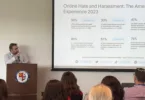by Kara Hansen
ATCHISON — In the northeastern-most corner of the archdiocese, numbers are only one of the factors that go into the calculations of the pastoral planning process.
When members of the task force began the pastoral planning process for the Atchison Region in January, they knew their region had the smallest number of families of any region in the archdiocese.
A similar demographic in another area might leave parishes struggling to meet the faith needs of their Catholic families. But the Atchison Region enjoys unique resources: the Benedictine Sisters of Mount St. Scholastica, the monks of St. Benedict’s Abbey, and Benedictine College.
“That region of our archdiocese has really great resources in the Benedictine community with the abbey, monastery, and college all serving Catholics there,” said Carroll Macke, communications director for the archdiocese.
At a meeting recently attended by task force members, parish leaders from throughout the region, Archbishop Joseph F. Naumann, and consultant Mike Maude, representatives of the three communities shared how their ministries and outreach programs helped meet the needs of the parishes in the region.
The Benedictine Sisters, for example, offer ministries of prayer, adult formation for rural parishes, retreats, and parish outreach programs. The Benedictine monks staff some parishes, provide weekend sacramental assistance at others, direct retreats, provide School of Faith teachers and more.
Through Benedictine College, students provide services to the parishes as well. Their activities range from offering retreats to working as youth ministers in parishes to participating in blood drives to providing meals to low-income families.
“We’re really very spoiled in Atchison that so many college students teach in our CCD programs, and they’re very dedicated,” said Father Gerard Senecal, OSB, pastor of St. Benedict’s and Sacred Heart parishes in Atchison and leader of the pastoral planning task force.
The pastoral planning process begins with the task force gathering facts and information about the region to determine what changes might need to be made to enhance long-term vitality. Parish vitality is measured in various ways, but includes an evaluation of how high a priority each parish makes conversion, evangelization, Catholic education, stewardship, and serving those in need.
In an effort to keep the lines of communication as open as possible with parishioners in the region, regular updates are provided to parishioners through their church’s weekly bulletin.
“We really try to keep parishioners updated about what’s going on throughout the process,” said Macke.
Maude has been hired by the archdiocese to assist with the process. So far, he has interviewed all the pastors in the region and held listening sessions at each of the parishes to help gather feedback and ideas about the planning process. The task force will work with all of the information gathered to make recommendations to the archbishop and presbyteral council to help develop a strategic plan for the Atchison Region.
“This can be a painful but necessary process that will give new vitality to our parishes,” said Father Gerard.
A second round of parish meetings will be held in April and May to give parishioners a chance to respond to the proposed recommendations. It is expected that the final recommendations will be ready to submit to the archbishop for his approval sometime this summer.
Father Gerard said task force members have to be mindful throughout the process of how the needs and priorities of each parish might look slightly different.
“A parish with 40 families is going to have a very different set of ideals than a parish with 600 families,” he said. “There’s going to be a different fit to every parish.”
The Atchison Region is comprised of 15 parishes spread through four counties, and numbers some 2,200 Catholic families. Seven priests serve the parishes, which are scattered throughout the region. Father Gerard said that of the four counties included in the region, only Jefferson County’s population is on the rise.






